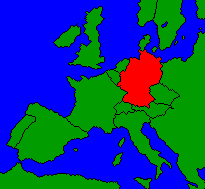

Seventeenth Century Germany
|
| The "Praetorius Organ" | The Pedal | Quiz |
|
IntroductionFrom time to time it may seem that organists live in a world apart from other musicians. Many historical names that we associate with the history of our instrument and its literature are completely unknown to other musicians. Most music students, for example, never have any reason to learn of Arnolt Schlick or his treatise.147 Michael Praetorius, however, is a different case, because his major publication, however important it may be to organists, is much broader in scope, covering many different topics and types of musical instruments. Even undergraduate music history texts talk about his contributions in general studies of late sixteenth- and early seventeenth-century music.149 From 1615 through 1620 Praetorius published Syntagma musicum, an three-volume encyclopedic treatise on music. The second volume (de Organographia) describes musical instruments that were in use during his lifetime, including engravings showing how they looked and even how they were played. Most importantly for us, he also described the organ of the Groningen Court chapel, built by David Beck and completed in 1596. That instrument should not be taken as representing "the" Dutch or German organ of the first half of the seventeenth century. There are several reasons, however, for your knowing about it in some detail;
|
| Top of Page | The "Praetorius Organ" | The Pedal | Quiz |
The "Praetorius Organ"The Groningen Court Chapel organ described by Praetorius is no longer extant, but the case survives in the Martinskirche in Halberstadt, south of Hamburg, Germany. Part of the stoplist reads as follows:151 |
| Oberwerk | Rückpositiv | Brustwerk | |||||
|---|---|---|---|---|---|---|---|
| Gross Quintadehna | 16 | Quintadehn | 8 | Klein Gedact | 2 | ||
| Principal | 8 | Principal | 4 | Klein Octava | 1 | ||
| Gross Querflöit | 8 | Gemsshorn | 4 | Klein Mixtur | |||
| Holflöiten | 8 | Gedact | 4 | Zimbeldoppelt | |||
| Gemshorn | 8 | Octava | 2 | Rancket | 8 | ||
| Grobgedact | 8 | Spitzflöite | 2 | Regal | 8 | ||
| Quinta | 5 1/3 | Quinta | 1 1/3 | Zimbel Regal | 2 | ||
| Octava | 4 | Subflöite | 1 | ||||
| Nachthorn | 4 | Mixtur | |||||
| Klein Querflöite | 4 | Zimbel | |||||
| Mixtur | Sordunen | 16 | |||||
| Zimbeldoppelt | Krumbhorn | 8 | |||||
| Trommet | 8 | ||||||
| Klein Regal | 4 | ||||||
|
Now - - part of this looks fairly normal when compared to other organs you may have seen. The
names of the divisions are not unusual as given here. The primary manual division is called
Oberwerk instead of the more common Hauptwerk, but names of divisions in German indicate
relative position in the case, and there is no confusion here: the "head" is above the "breast."141 Looking at the disposition of stops, several elements were no doubt
standard by this time, having been found in northern European instruments a hundred years earlier.150 For example, the stops of a principal chorus are present on the
Oberwerk, a secondary chorus (based on a 4' Principal) is found on the Rückpositiv,
and short-resonator reeds are included on both Rückpositiv and Brustwerk divisions.
On the other hand, several other characteristics might strike you as being somewhat unusual.
You can summarize the characteristics of the manual stoplist by saying that it includes
|
| Top of Page | The "Praetorius Organ" | The Pedal | Quiz |
|
The PedalEven though you can understand some of the apparent anomalies of the three manual divisions in the way described above, the stoplist for the pedal is another story: |
| Upper Pedal (Stops on the Oberwerk Chest) | Pedal Towers | Brust Pedal (Stops on chests to the side of the Brustwerk) | |||||
|---|---|---|---|---|---|---|---|
| Untersatz | 16 | Gross Principal Bass | 16 | Quitflöiten Bass | 10 2/3 | ||
| Quintadeen Bass | 16 | Gross Gemsshorn Bass | 16 | Bawrflöiten Bass | 4 | ||
| Octaven Bass | 8 | Gross Querflöiten Bass | 8 | Zimbel Bass | |||
| Holquinten Bass | Gemsshorn Bass | 8 | Rancket Bass | 8 | |||
| Klein Octaven Bass | 4 | Quintflöiten Bass | 5 1/3 | Krumbhorn Bass | 8 | ||
| Nachthorn Bass | 4 | Kleingedact Bass | 4 | Klein Regal Bass | 4 | ||
| Klein Quintadeen Bass | 4 | Posaunen Bass | 16 | ||||
| Holflöiten Bass | 2 | Sordunen Bass | 16 | ||||
| Rauschquinten Bass | Trommeten Bass | 8 | |||||
| Mixtur | Schallmeyen Bass | 4 | |||||
As you can see, this lengthy list immediately raises two questions:
|

|
| This page is incomplete. This section will be enlarged later. |
| Top of Page | The "Praetorius Organ" | The Pedal | Quiz |
© 2000 AD James H. Cook